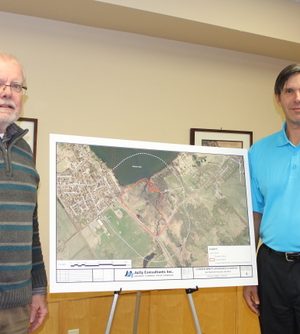By CONNIE TABBERT
Editor
COBDEN — It was a disappointing turnout by the residents of Cobden at the informational open house to provide their comments or just review the various options for upgrades to the Waste Water Treatment Plant.
“I’m not surprised, but I’m disappointed,” said Steve Hodson, waste management manager for the Township of Whitewater Region. “I was hoping there would be more local interest.”
However, he’s hopeful there will be comments through the township’s website.
The engineering firm, J2PG from Pembroke, has been working on this project since about 2014. Mr. Hodson is hopeful it will be completed by 2020. Council has had opportunity to review the project throughout the process so far. It’s now at a stage where public consultation is required, Mr. Hodson said.
To make it easier for the public to understand why the upgrade is required and how the project would be completed, large placards were provided for people to review.
Keven Mooder, an environmental planner with J2PG, noted six options were provided once it was agreed the 36-year-old plant needs some tender loving care.
The problems with the aging plant include:
• Inflow and infiltration concerns with sanitary collection system.
It was noted some storm water is getting in the system, which is forcing unnecessary treatment of water that shouldn’t be treated. There are also homes hooked up to the storm water system through sump pumps and eaves troughs, which is also causing water to be unnecessarily treated.
• Insufficient Waste Water Treatment Plant (WWTP) servicing capacity for current and future growth.
If there is to be development in Cobden, the plant must be upgraded to take on new service hook-ups.
• Plant does not allow for major service repairs and has inadequate sludge storage capacity.
Mr. Hodson noted it’s difficult at times to get parts for repairs due to the building’s age and the sludge is the biological liquid that is spread on fields. However, storage is required for this sludge, because it can only be spread at certain times of the year and only following approval by the Ministry of Environment and Climate Change.
• Environmental status of Muskrat Lake as it relates to the current and future WWTP effluent concentration.
It’s been noted that the lake has a high concentration of phosphorous, and while the wastewater plant isn’t the sole contributor, it is one, said Mr. Mooder.
The consultants have been reviewing the problems and provided six options to deal with the plant’s problems, Mr. Mooder said.
The options are:
1. Do nothing and limit growth
2. Reduce extraneous flows
3. Upgrade existing WWTP: add tertiary treatment and sludge storage.
4. Upgrade existing WWTP: new parallel treatment unit(s), tertiary treatment and sludge storage
5. Decommission existing WWTP, construct new mechanical treatment systems, including tertiary treatment and sludge storage.
6. Septage management.
“Number One is not really an option,” Mr. Mooder said.
Bob Lecraw, a process engineer and a wastewater treatment plant specialist, said a recommendation will be made to council, however, it won’t be just one of the options. It will most likely be a combination of two and four, he said.
To come up with the recommendation, Mr. Mooder said various criteria were used and applied to the alternatives. Some of the criteria included land ownership, physical constraints, air environment and birds, water environment and aquatic flora/fauna, community development, aesthetics, cultural heritage and archaeology, capital costs and funding limitations.
Another placard explained how the project was to be completed through five phases. Phase One, which is defining the problem/opportunity and Phase Two is coming up with the solutions and holding the public consultation meetings.
Once council agrees which option it will go with, Phase Three begins, which is the design concept for the preferred solution.
Along with getting public comments, Mr. Mooder said various agencies also have opportunity to comment. These agencies include the Ministry of Environment and Climate Change, Algonquins of Ontario, Ministry of Natural Resources, Ontario Ministry of Agriculture, Food and Rural Affairs and the Renfrew County District Health Unit, as well as site specific agencies, which are the various utilities.
It’s expected that comments will be accepted until the end of January and then they will be compiled, reviewed and within two months a recommendation will be made to council, Mr. Mooder said. Once approval has been received, Phase 3 will begin, he said.
For those who didn’t have opportunity to attend the open house, comments, questions and concerns can be submitted through the township website. Mr. Mooder said Mr. Hodson is the point of contact person for those who are not able to use the Internet.
This is about a $9 million project, Mr. Hodson said. It will be funded in three ways. The provincial and federal governments have each provided $3 million with the township paying the rest, he said. Throughout the process, the project will be budgeted in so it’s not one large cost. Mr. Hodson said council will have to take out a debenture (loan) to pay its share. Since the WWTP is a user-pay system, it’s only those hooked up to it who will bear the cost of the project, not all township taxpayers, he explained.
For those who have questions, concerns and comments, while it’s preferable they be in writing, Mr. Hodson can be reached at 613-646-2282, ext. 127.
If you would like to review the 75-page Municipal Class Environmental Assessment report, go to the township’s website and click on the WWRNews heading.







![Kenopic/Smith Auction [Paid Ad]](https://whitewaternews.ca/wp-content/uploads/2018/10/advertising-100x75.jpeg)

